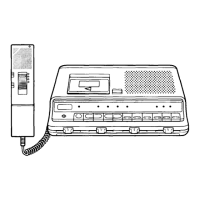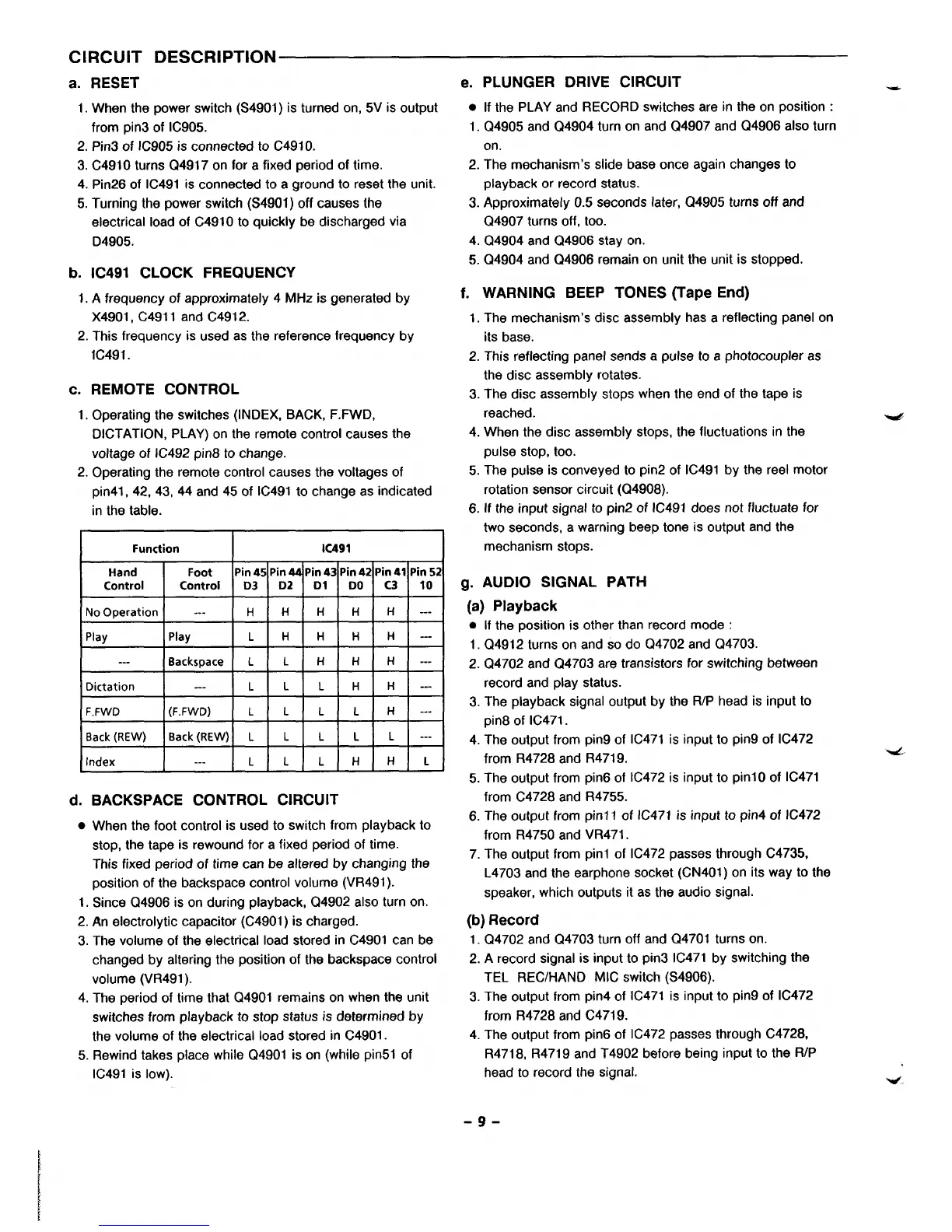CIRCUIT DESCRIPTION
a. RESET
1. When the power switch (S4901 ) is turned on, 5V is output
from pin3 of IC905.
2. Pin3 of IC905 is connected to C491 O.
3. C491 O turns Q4917 on for a fixed period of time.
4. Pin26 of IC491 is connected to a ground to reset the unit.
5. Turning the power switch (S4901 ) off causes the
electrical load of C491 O to quickly be discharged via
D4905.
b. IC491 CLOCK FREQUENCY
1.
A frequency of approximately 4 MHz is generated by
X4901, C4911 and C4912.
2. This frequency is used as the reference frequency by
c.
1
1C491 .
REMOTE CONTROL
Operating the switches (INDEX, BACK, F.FWD,
DICTATION, PLAY) on the remote control causes the
voltage of IC492 pin8 to change.
2. Operating the remote control causes the voltages of
pin41, 42, 43, 44 and 45 of IC491 to change as indicated
in the table.
Function IC491
Hand
Foot
Pin 45 Pin
44 Pin 43 Pin 42 Pin 41 Pin 52
Control Control D3 D2 D1 DO C3
10
No Operation --- H H H H H ---
Play Play L H H H H ---
---
Backspace L L H H H ---
Dictation
---
L L L H H ---
F.FWD (F.FWD) L L L L H ---
Back (REW)
Back (REW) L L L L L ---
Index
...
L L L H H L
d. BACKSPACE CONTROL CIRCUIT
. When the foot control is used to switch from playback to
stop, the tape is rewound for a fixed period of time.
This fixed period of time can be altered by changing the
position of the backspace control volume (VR491 ).
1. Since Q4906 is on during playback, Q4902 also turn on.
2. An electrolytic capacitor (C4901 ) is charged.
3. The volume of the electrical load stored in C4901 can be
changed by altering the position of the backspace control
volume (VR491 ).
4. The period of time that Q4901 remains on when the unit
switches from playback to stop status is determined by
the volume of the electrical load stored in C4901.
5. Rewind takes place while Q4901 is on (while pin51 of
IC491 is low).
e. PLUNGER DRIVE CIRCUIT
● If the PLAY and RECC)RD switches are in the on position :
1. Q4905 and Q4904 turn on and Q4907 and Q4906 also turn
on.
2. The mechanism’s slide base once again changes to
playback or record status.
3. Approximately 0.5 seconds later, Q4905 turns off and
Q4907 turns off, too.
4. Q4904 and Q4906 stay on.
5. Q4904 and Q4906 remain on unit the unit is stopped.
f. WARNING BEEP TONES (Tape End)
1. The mechanism’s disc assembly has a reflecting panel on
its base.
2. This reflecting panel sends a pulse to a photocoupler as
the disc assembly rotates.
3. The disc assembly stops when the end of the tape is
reached.
e
4. When the disc assembly stops, the fluctuations in the
pulse stop, too.
5. The pulse is conveyed to pin2 of IC491 by the reel motor
rotation sensor circuit (Q4908).
6. If the input signal to pin2 of IC491 does not fluctuate for
two seconds, a warning beep tone is output and the
mechanism stops.
g. AUDIO SIGNAL PATH
(a) Playback
● If the position is other than record mode :
1. Q4912 turns on and so do Q4702 and Q4703.
2. Q4702 and Q4703 are transistors for switching between
record and play status.
3. The playback signal output by the R/P head is input to
pin8 of IC471.
4. The output from pin9 of IC471 is input to pin9 of IC472
from R4728 and R4719.
d
5. The output from pin6 of IC472 is input to pin10 of IC471
from C4728 and R4755.
6. The output from pinl 1 of IC471 is input to pin4 of IC472
from R4750 and VR471.
7. The output from pinl of IC472 passes through C4735,
L4703 and the earphone socket (CN401 ) on its way to the
speaker, which outputs it as the audio signal.
(b) Record
1. Q4702 and Q4703 turn off and Q4701 turns on.
2. A record signal is input to pin3 IC471 by switching the
TEL REC/HAND MIC switch (S4906).
3. The output from pin4 of IC471 is input to pin9 of IC472
from R4728 and C4719.
4. The output from pin6 of IC472 passes through C4728,
R4718, R4719 and T4902 before being input to the R/P
head to record the signal.
-9-

